Attached files
| file | filename |
|---|---|
| 8-K - FORM 8-K - ASSEMBLY BIOSCIENCES, INC. | v456522_8k.htm |
Exhibit 99.1
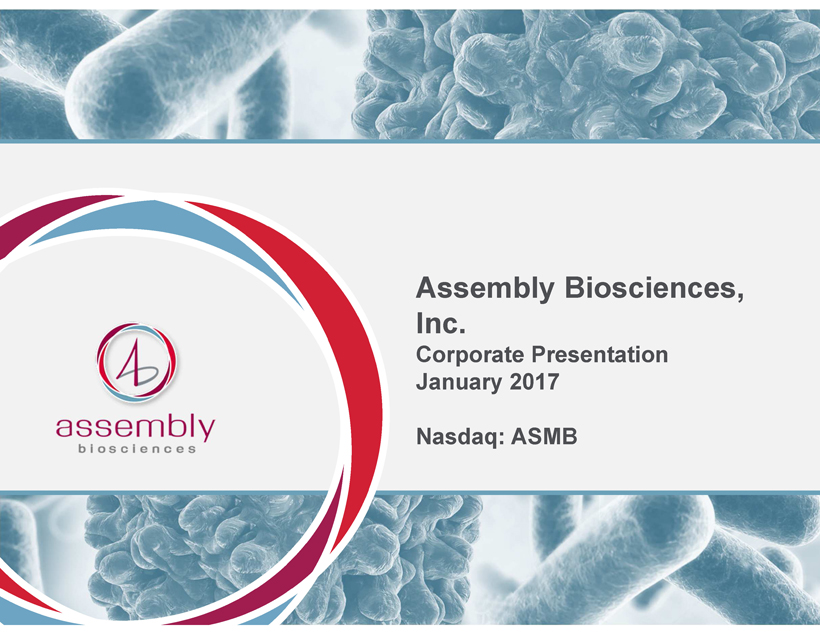
Assembly Biosciences, Inc. Corporate Presentation January 2017 Nasdaq: ASMB
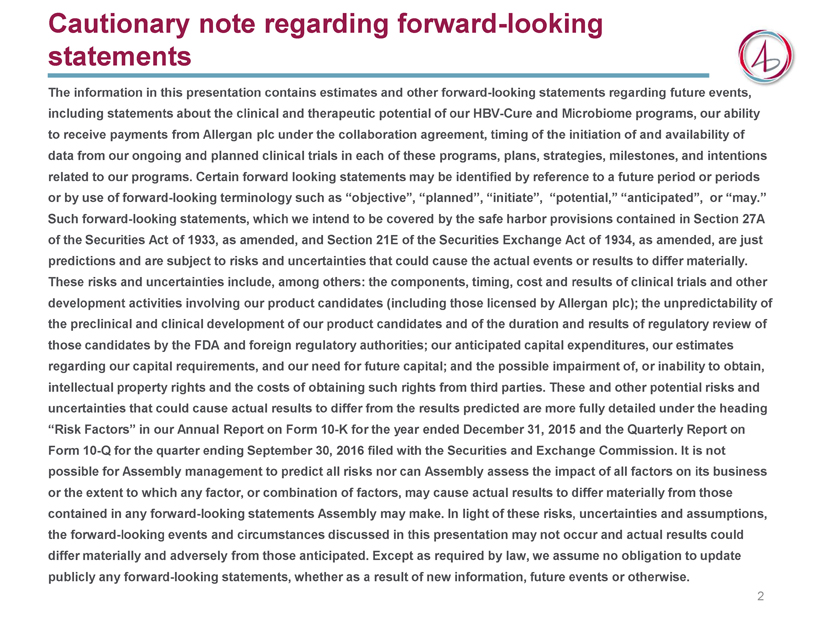
Cautionary note r egarding forward - looking s tatements The information in this presentation contains estimates and other forward - looking statements regarding future events, including statements about the clinical and therapeutic potential of our HBV - Cure and Microbiome programs, our ability to receive payments from Allergan plc under the collaboration agreement, timing of the initiation of and availability of data from our ongoing and planned clinical trials in each of these programs, plans, strategies, milestones, and intentions related to our programs. Certain forward looking statements may be identified by reference to a future period or periods or by use of forward - looking terminology such as “objective”, “planned”, “initiate”, “potential,” “anticipated”, or “may.” Such forward - looking statements, which we intend to be covered by the safe harbor provisions contained in Section 27A of the Securities Act of 1933, as amended, and Section 21E of the Securities Exchange Act of 1934, as amended, are just predictions and are subject to risks and uncertainties that could cause the actual events or results to differ materially. These risks and uncertainties include, among others: the components, timing, cost and results of clinical trials and other development activities involving our product candidates (including those licensed by Allergan plc); the unpredictability of the preclinical and clinical development of our product candidates and of the duration and results of regulatory review of those candidates by the FDA and foreign regulatory authorities; our anticipated capital expenditures, our estimates regarding our capital requirements, and our need for future capital; and the possible impairment of, or inability to obtain, intellectual property rights and the costs of obtaining such rights from third parties. These and other potential risks and uncertainties that could cause actual results to differ from the results predicted are more fully detailed under the heading “Risk Factors” in our Annual Report on Form 10 - K for the year ended December 31, 2015 and the Quarterly Report on Form 10 - Q for the quarter ending September 30, 2016 filed with the Securities and Exchange Commission. It is not possible for Assembly management to predict all risks nor can Assembly assess the impact of all factors on its business or the extent to which any factor, or combination of factors, may cause actual results to differ materially from those contained in any forward - looking statements Assembly may make. In light of these risks, uncertainties and assumptions, the forward - looking events and circumstances discussed in this presentation may not occur and actual results could differ materially and adversely from those anticipated. Except as required by law, we assume no obligation to update publicly any forward - looking statements, whether as a result of new information, future events or otherwise. 2
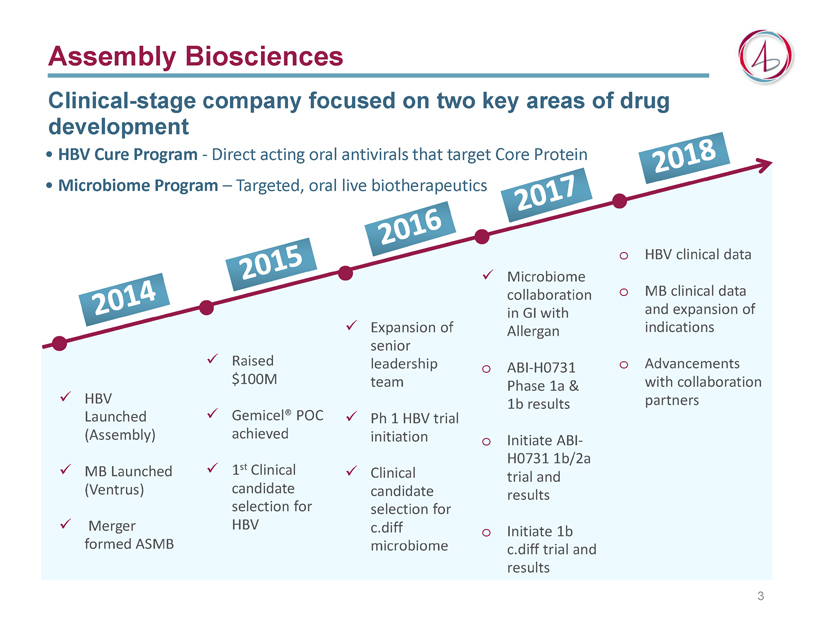
Assembly Biosciences 3 x Microbiome collaboration in GI with Allergan o ABI - H0731 Phase 1 a & 1b results o Initiate ABI - H0731 1b/2a trial and results o Initiate 1b c.diff trial and results Clinical - stage company focused on two key areas of drug development x Expansion of senior leadership team x Ph 1 HBV trial initiation x Clinical candidate selection for c.diff microbiome o HBV clinical data o MB clinical data and expansion of indications o Advancements with collaboration partners x Raised $ 100M x Gemicel ® POC achieved x 1 st Clinical candidate selection for HBV x HBV Launched (Assembly ) x MB Launched (Ventrus ) x Merger formed ASMB • HBV Cure Program - Direct acting oral antivirals that target Core Protein • Microbiome Program – Targeted, oral live biotherapeutics
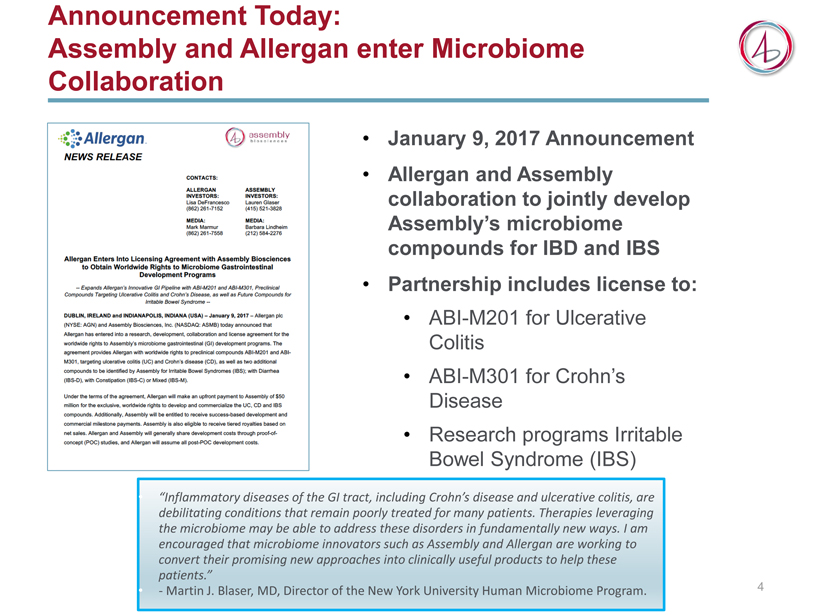
Announcement Today: Assembly and Allergan enter Microbiome Collaboration • January 9, 2017 Announcement • Allergan and Assembly collaboration to jointly develop Assembly’s microbiome compounds for IBD and IBS • Partnership includes license to: • ABI - M201 for Ulcerative Colitis • ABI - M301 for Crohn’s Disease • Research programs Irritable Bowel Syndrome (IBS) 4 • “ Inflammatory diseases of the GI tract, including Crohn’s disease and ulcerative colitis, are debilitating conditions that remain poorly treated for many patients. Therapies leveraging the microbiome may be able to address these disorders in fundamentally new ways. I am encouraged that microbiome innovators such as Assembly and Allergan are working to convert their promising new approaches into clinically useful products to help these patients .” • - Martin J. Blaser, MD, Director of the New York University Human Microbiome Program.
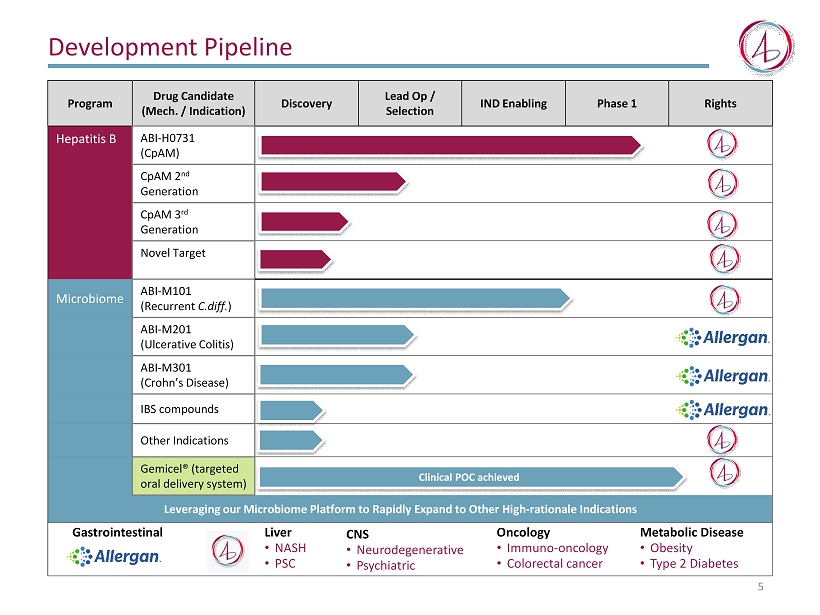
Program Drug Candidate (Mech. / Indication) Discovery Lead Op / Selection IND Enabling Phase 1 Rights Hepatitis B ABI - H0731 (CpAM) CpAM 2 nd Generation CpAM 3 rd Generation Novel Target Microbiome ABI - M101 (Recurrent C.diff. ) ABI - M201 (Ulcerative Colitis ) ABI - M301 (Crohn’s Disease) IBS compounds Other Indications Gemicel® (targeted oral delivery system) Leveraging our Microbiome Platform to Rapidly Expand to Other High - rationale Indications Gastrointestinal Oncology • Immuno - oncology • Colorectal cancer Metabolic Disease • Obesity • Type 2 Diabetes CNS • Neurodegenerative • Psychiatric 5 Liver • NASH • PSC Development Pipeline Clinical POC achieved
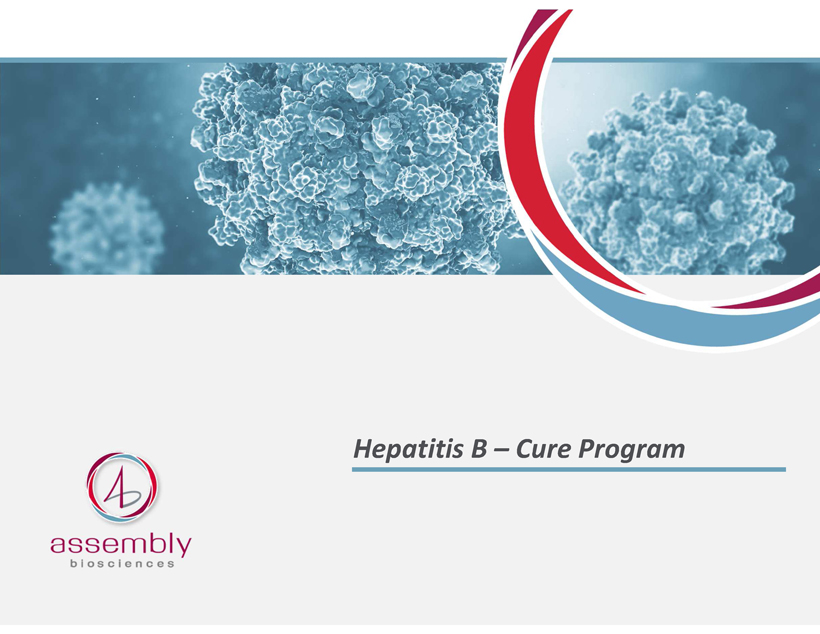
Hepatitis B – Cure Program
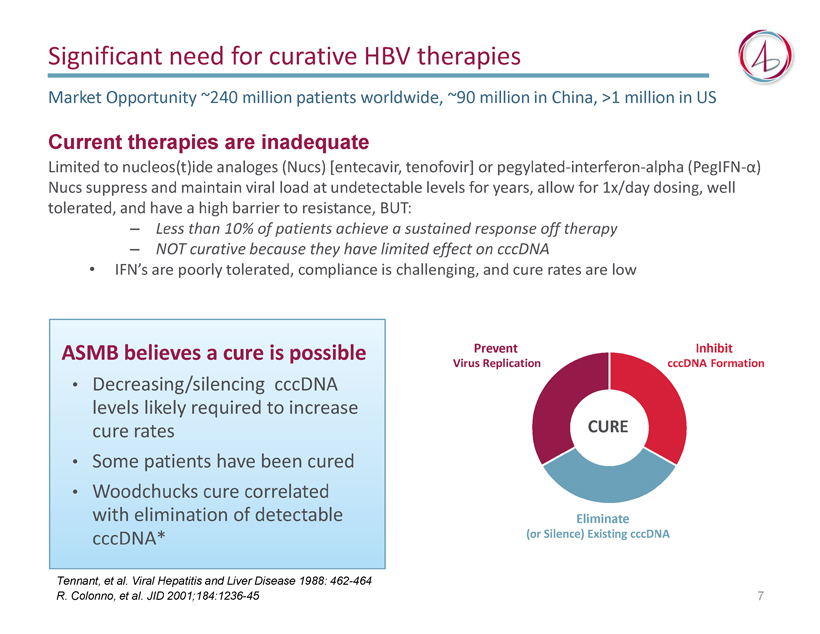
Significant need for curative HBV therapies Market Opportunity ~ 240 million patients worldwide, ~90 million in China, >1 million in US CURE Eliminate (or Silence) Existing cccDNA Inhibit cccDNA Formation Prevent Virus Replication Limited to nucleos(t)ide analoges (Nucs) [entecavir, tenofovir] or pegylated - interferon - alpha (PegIFN - α) Nucs suppress and maintain viral load at undetectable levels for years, allow for 1x/day dosing, well tolerated, and have a high barrier to resistance, BUT: – Less than 10% of patients achieve a sustained response off therapy – NOT curative because they have limited effect on cccDNA • IFN’s are poorly tolerated, compliance is challenging, and cure rates are low Current therapies are inadequate ASMB believes a cure is possible • Decreasing/silencing cccDNA levels likely required to increase cure rates • Some patients have been cured • Woodchucks cure correlated with elimination of detectable cccDNA* 7 Tennant , et al. Viral Hepatitis and Liver Disease 1988: 462 - 464 R. Colonno, et al. JID 2001;184:1236 - 45
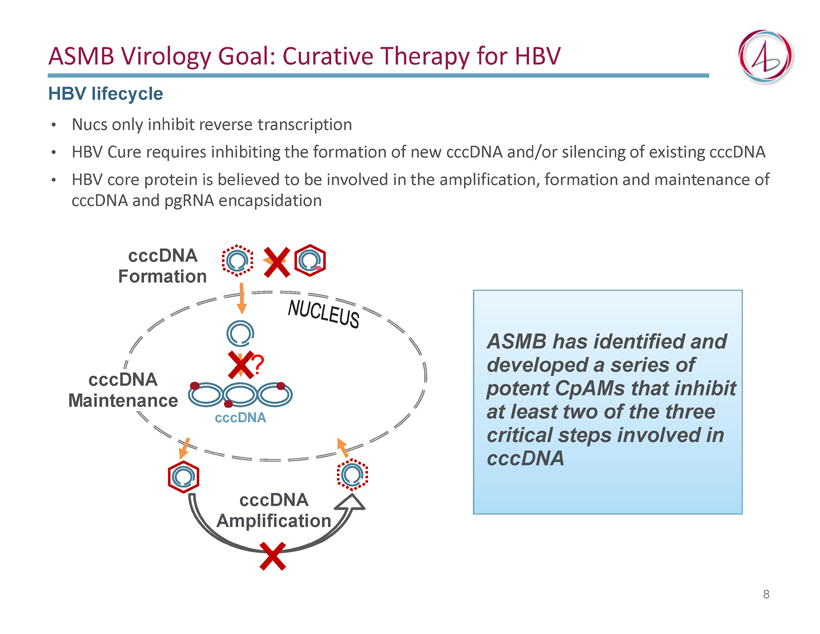
ASMB Virology Goal : Curative Therapy for HBV • Nucs only inhibit reverse transcription • HBV Cure requires inhibiting the formation of new cccDNA and/or silencing of existing cccDNA • HBV core protein is believed to be involved in the amplification, formation and maintenance of cccDNA and pgRNA encapsidation cccDNA cccDNA Formation cccDNA Amplification cccDNA Maintenance ? ASMB has identified and developed a series of potent CpAMs that inhibit at least two of the three critical steps involved in cccDNA 8 HBV lifecycle
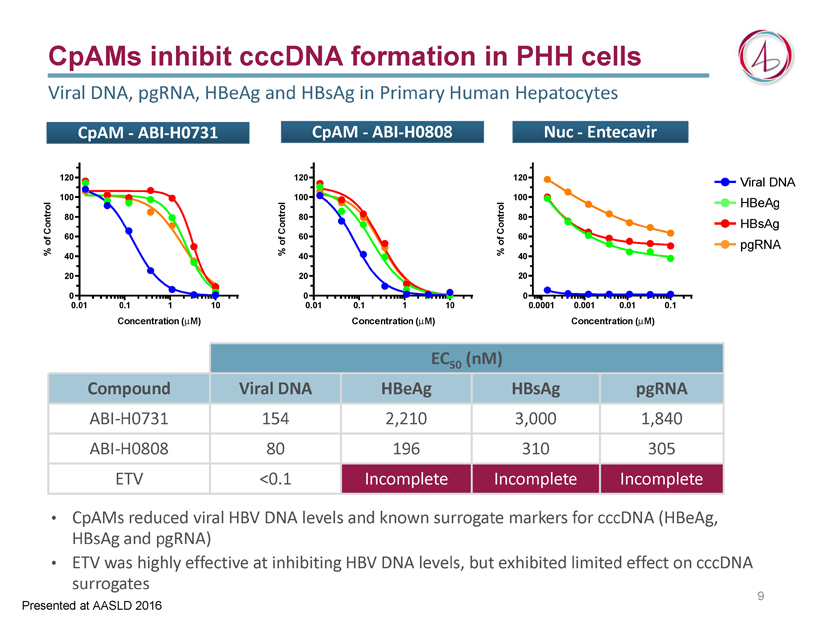
CpAMs inhibit cccDNA f ormation in PHH cells Viral DNA, pgRNA, HBeAg and HBsAg in Primary Human Hepatocytes EC 50 (nM) Compound Viral DNA HBeAg HBsAg pgRNA ABI - H0731 154 2,210 3,000 1,840 ABI - H0808 80 196 310 305 ETV <0.1 Incomplete Incomplete Incomplete Viral DNA HBeAg HBsAg pgRNA CpAM - ABI - H0731 0.01 0.1 1 10 0 20 40 60 80 100 120 Concentration (mM) % o f C o n t r o l CpAM - ABI - H0808 0.01 0.1 1 10 0 20 40 60 80 100 120 Concentration (mM) % o f C o n t r o l Nuc - Entecavir 0.0001 0.001 0.01 0.1 0 20 40 60 80 100 120 Concentration (mM) % o f C o n t r o l • CpAMs reduced viral HBV DNA levels and known surrogate markers for cccDNA (HBeAg, HBsAg and pgRNA) • ETV was highly effective at inhibiting HBV DNA levels, but exhibited limited effect on cccDNA surrogates 9 • Presented at AASLD 2016
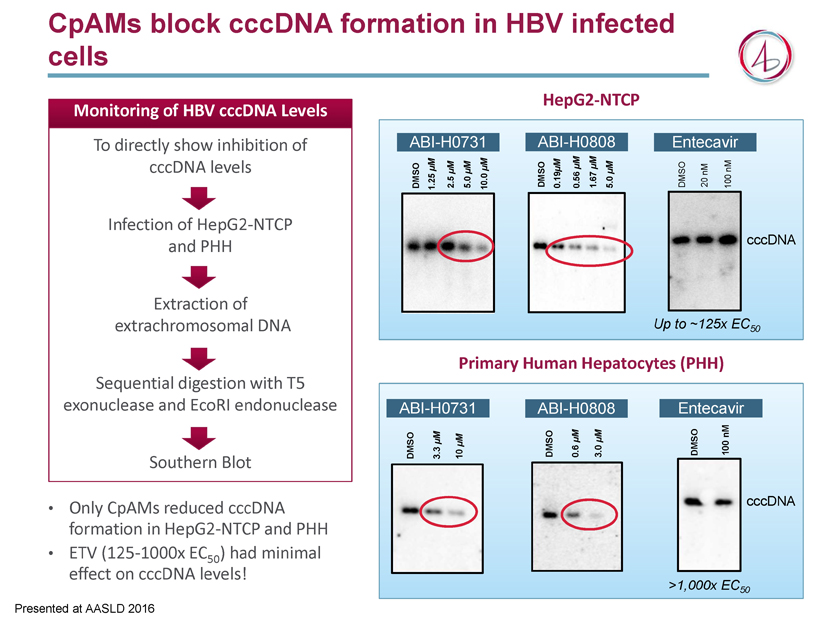
CpAMs block cccDNA formation in HBV infected c ells HepG2 - NTCP Primary Human Hepatocytes (PHH) U p to ~ 125x EC 50 Entecavir DMSO 20 nM 100 nM DMSO 3.3 µM 10 µM ABI - H0731 >1,000x EC 50 Entecavir DMSO 100 nM ABI - H0731 DMSO 1.25 µM 2.5 µM 5.0 µM 10.0 µM cccDNA • Only CpAMs reduced cccDNA formation in HepG2 - NTCP and PHH • ETV (125 - 1000x EC 50 ) had minimal effect on cccDNA levels! ABI - H0808 ABI - H0808 DMSO 0.19 µM 0.56 µM 1.67 µM 5 .0 µM cccDNA DMSO 0.6 µM 3.0 µM To directly show inhibition of cccDNA levels Infection of HepG2 - NTCP and PHH Extraction of extrachromosomal DNA Sequential digestion with T5 exonuclease and EcoRI endonuclease Southern Blot Monitoring of HBV cccDNA Levels • Presented at AASLD 2016
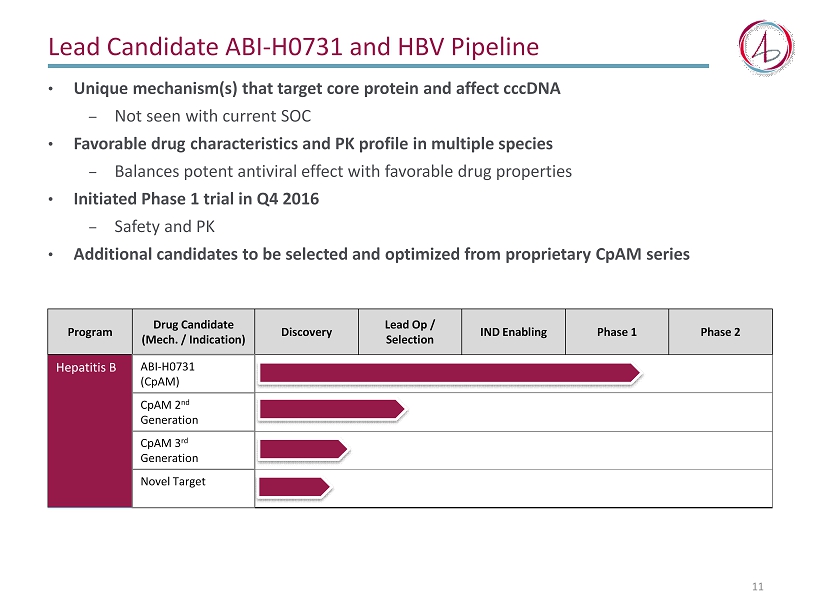
Lead Candidate ABI - H0731 and HBV Pipeline • Unique mechanism(s) that target core protein and affect cccDNA – Not seen with current SOC • F avorable drug characteristics and PK profile in multiple species ‒ Balances potent antiviral effect with favorable drug properties • Initiated Phase 1 trial in Q4 2016 ‒ Safety and PK • Additional candidates to be selected and optimized from proprietary CpAM series 11 Program Drug Candidate (Mech. / Indication) Discovery Lead Op / Selection IND Enabling Phase 1 Phase 2 Hepatitis B ABI - H0731 (CpAM) CpAM 2 nd Generation CpAM 3 rd Generation Novel Target
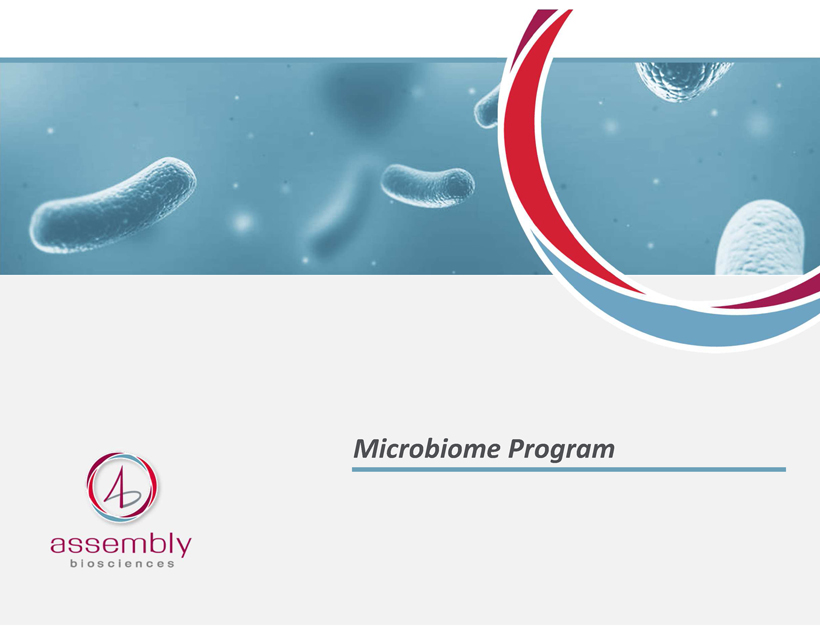
Microbiome Program
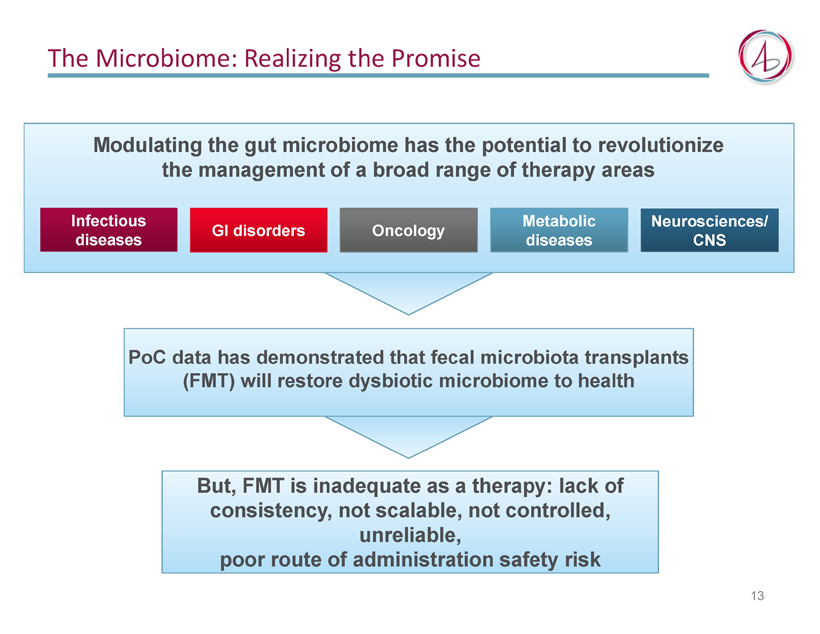
The Microbiome : Realizing the Promise Modulating the gut microbiome has the potential to revolutionize the management of a broad range of therapy areas Infectious diseases GI disorders Oncology Metabolic diseases Neurosciences/C NS PoC data has demonstrated that fecal microbiota transplants (FMT) will restore dysbiotic microbiome to health But, FMT is inadequate as a therapy: lack of consistency, not scalable, not controlled, unreliable, poor route of administration safety risk 13
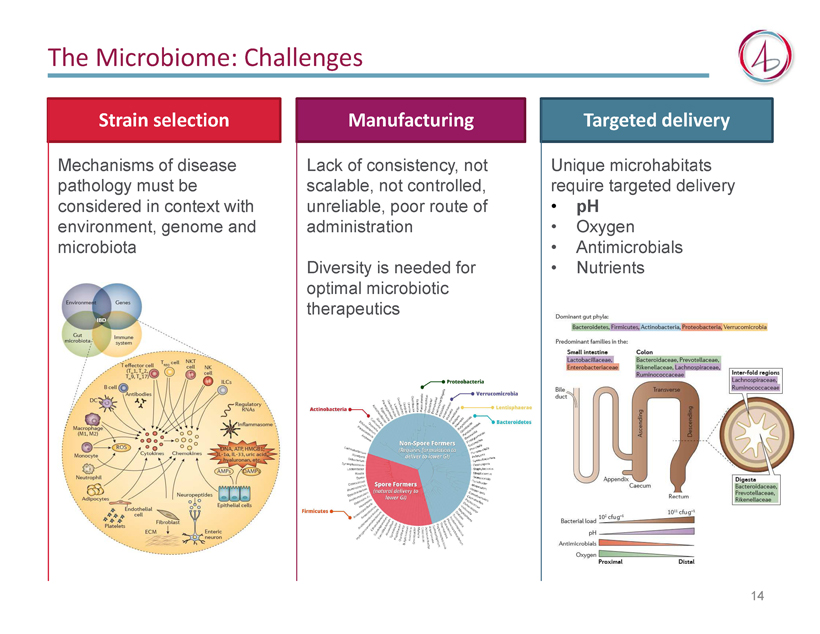
The Microbiome : Challenges 14 Mechanisms of disease pathology must be considered in context with environment, genome and microbiota Lack of consistency, not scalable, not controlled, unreliable, poor route of administration Diversity is needed for optimal microbiotic therapeutics Unique microhabitats require targeted delivery • pH • Oxygen • Antimicrobials • Nutrients Strain selection Manufacturing Targeted delivery
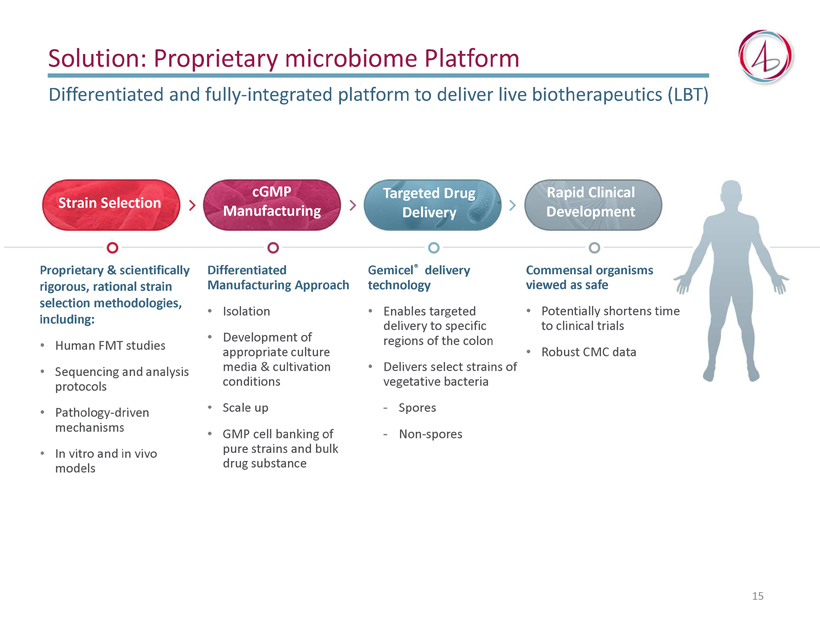
Solution: Proprietary microbiome P latform Proprietary & scientifically rigorous, rational strain selection methodologies, including: • Human FMT studies • Sequencing and analysis protocols • Pathology - driven mechanisms • In vitro and in vivo models Differentiated Manufacturing Approach • Isolation • Development of appropriate culture media & cultivation conditions • Scale up • GMP cell banking of pure strains and bulk drug substance Gemicel ® delivery technology • Enables targeted delivery to specific regions of the colon • Delivers select strains of vegetative bacteria - Spores - Non - spores Commensal organisms viewed as safe • Potentially shortens time to clinical trials • Robust CMC data Rapid Clinical Development Targeted Drug Delivery cGMP Manufacturing Strain Selection Differentiated and fully - integrated platform to deliver live biotherapeutics (LBT) 15
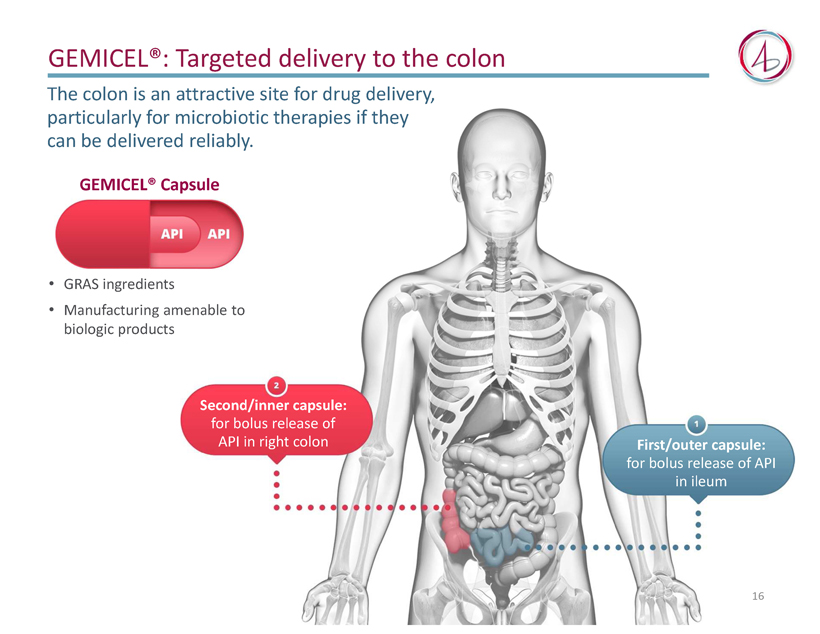
First/outer capsule: for bolus release of API in ileum Second/inner capsule: for bolus release of API in right colon GEMICEL®: Targeted delivery to the colon 16 • GRAS ingredients • Manufacturing amenable to biologic products GEMICEL® Capsule The colon is an attractive site for drug delivery, particularly for microbiotic therapies if they can be delivered reliably.
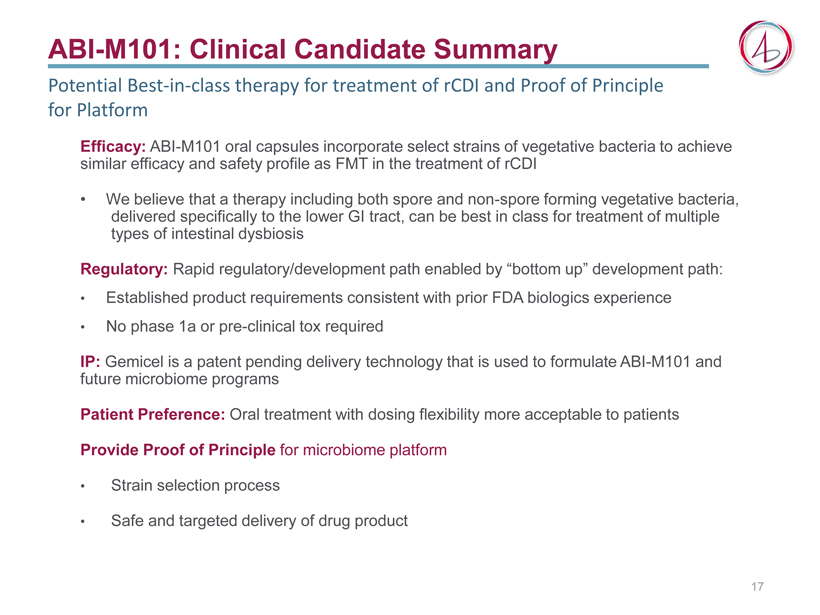
Efficacy: ABI - M101 oral capsules incorporate select strains of vegetative bacteria to achieve similar efficacy and safety profile as FMT in the treatment of rCDI • We believe that a therapy including both spore and non - spore forming vegetative bacteria, delivered specifically to the lower GI tract, can be best in class for treatment of multiple types of intestinal dysbiosis Regulatory: Rapid regulatory/development path enabled by “bottom up” development path: • Established product requirements consistent with prior FDA biologics experience • No phase 1a or pre - clinical tox required IP : Gemicel is a patent pending delivery technology that is used to formulate ABI - M101 and future microbiome programs Patient Preference: Oral treatment with dosing flexibility more acceptable to patients Provide Proof of Principle for microbiome platform • Strain selection process • Safe and targeted delivery of drug product ABI - M101: Clinical Candidate Summary B est - in - class therapy for treatment of rCDI and Proof of Principle for Platform 17
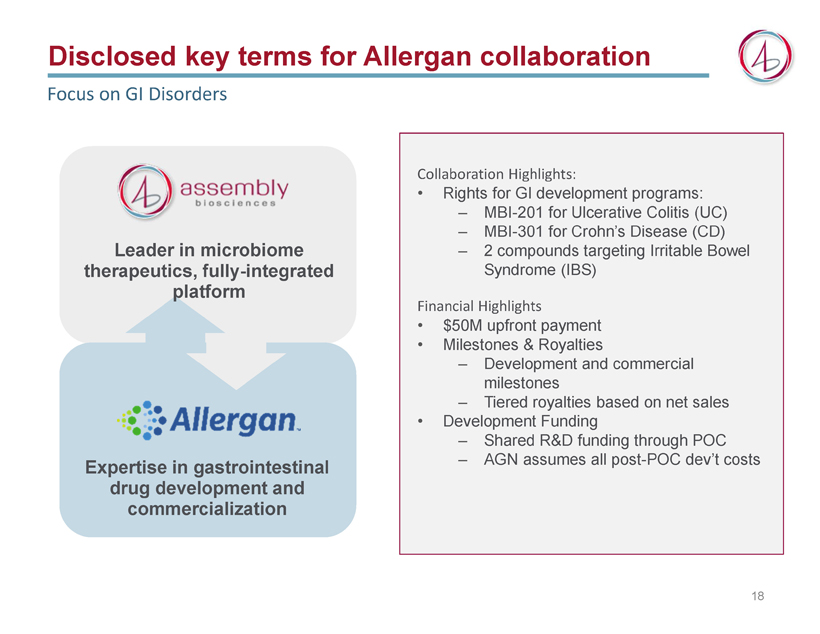
Disclosed key terms for Allergan collaboration 18 Leader in microbiome therapeutics, fully - integrated platform Expertise in gastrointestinal drug development and commercialization Collaboration Highlights: • Rights for GI development programs: ‒ MBI - 201 for Ulcerative Colitis (UC) ‒ MBI - 301 for Crohn’s Disease (CD) ‒ 2 compounds targeting Irritable Bowel Syndrome (IBS) Financial Highlights • $50M upfront payment • Milestones & Royalties ‒ Development and commercial milestones ‒ Tiered royalties based on net sales • Development Funding ‒ Shared R&D funding through POC ‒ AGN assumes all post - POC dev’t costs Focus on GI Disorders
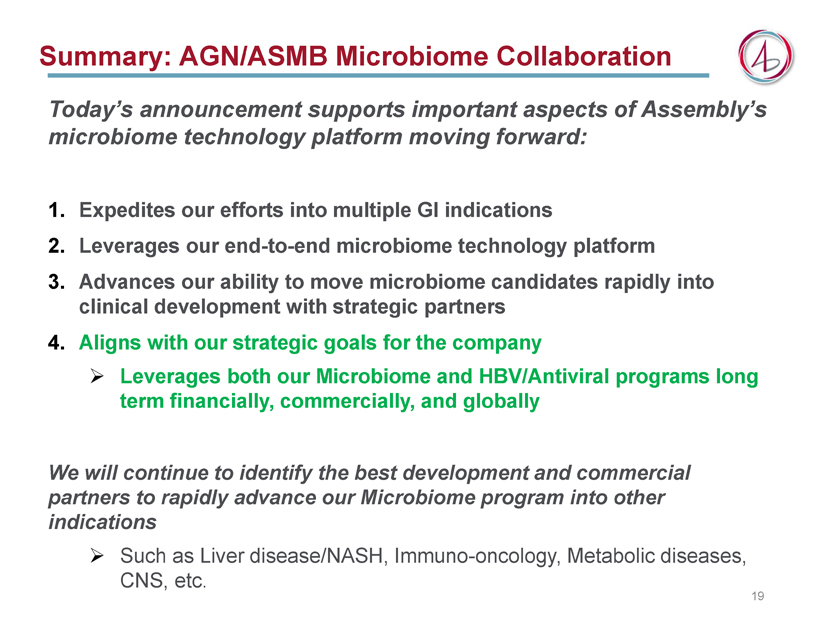
Summary: AGN/ASMB Microbiome Collaboration Today’s announcement supports important aspects of Assembly’s microbiome technology platform moving forward: 1. Expedites our efforts into multiple GI indications 2. Leverages our end - to - end microbiome technology platform 3. Advances our ability to move microbiome candidates rapidly into clinical development with strategic partners 4. Aligns with our strategic goals for the company » Leverages both our Microbiome and HBV/Antiviral programs long term financially, commercially, and globally We will continue to identify the best development and commercial partners to rapidly advance our Microbiome program into other indications » Such as Liver disease/NASH, Immuno - oncology, Metabolic diseases, CNS, etc. 19
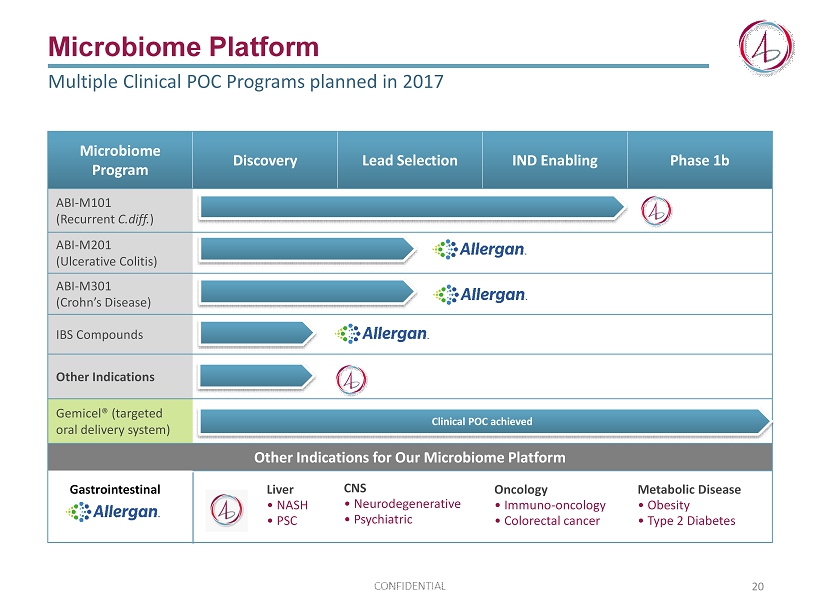
Microbiome Program Discovery Lead Selection IND Enabling Phase 1b ABI - M101 (Recurrent C.diff. ) ABI - M201 (Ulcerative Colitis ) ABI - M301 (Crohn’s Disease) IBS Compounds Other Indications Gemicel® (targeted oral delivery system) Other Indications for Our Microbiome Platform Clinical POC achieved Gastrointestinal Oncology • Immuno - oncology • Colorectal cancer Metabolic Disease • Obesity • Type 2 Diabetes CNS • Neurodegenerative • Psychiatric 20 Liver • NASH • PSC Microbiome Platform Multiple Clinical POC Programs planned in 2017
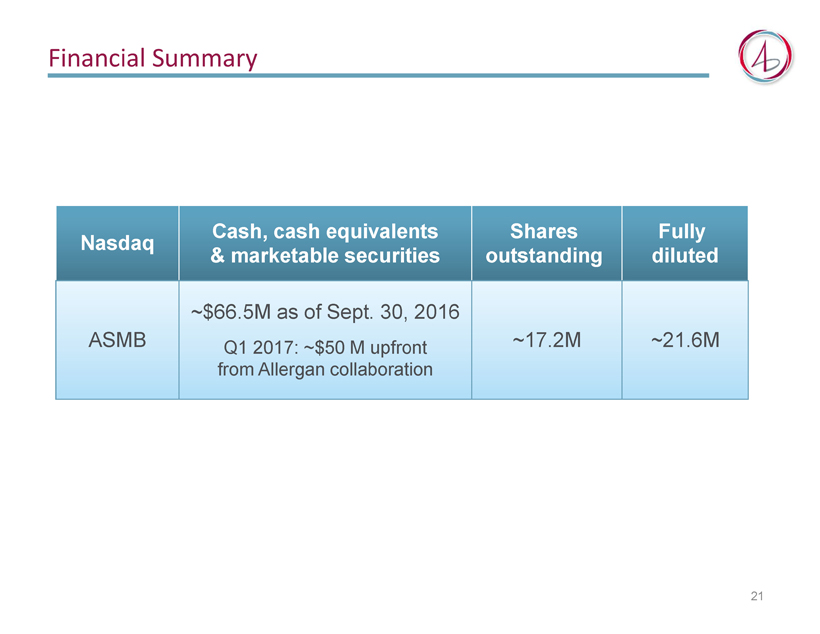
Financial Summary 21 Nasdaq ASMB Cash, cash equivalents & marketable securities ~$66.5M as of Sept. 30, 2016 Q1 2017: ~$50 M upfront from Allergan collaboration Shares outstanding ~17.2M Fully diluted ~ 21.6M
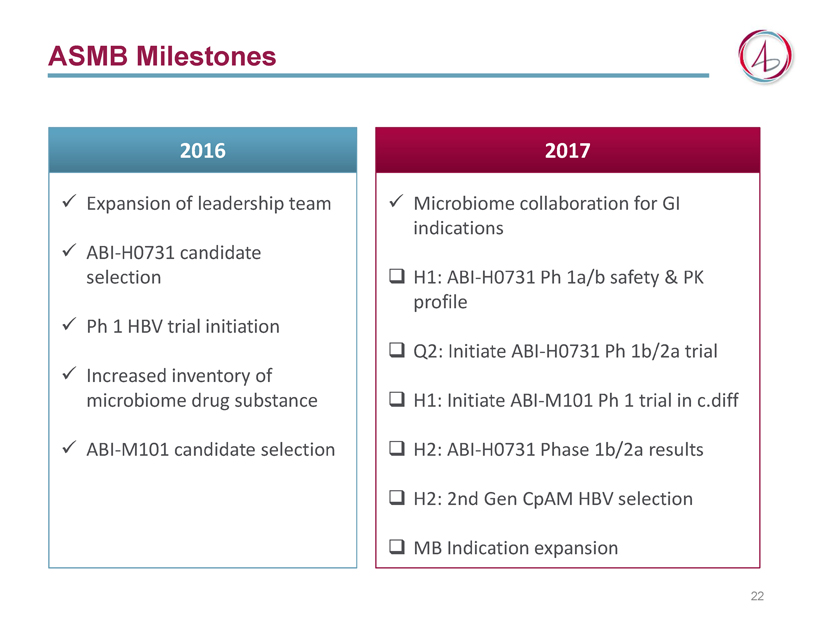
2016 ASMB Milestones 22 x Expansion of leadership team x ABI - H0731 candidate selection x Ph 1 HBV trial initiation x Increased inventory of microbiome drug substance x ABI - M101 candidate selection 2017 x Microbiome collaboration for GI indications □ H1: ABI - H0731 Ph 1a/b safety & PK profile □ Q2: Initiate ABI - H0731 Ph 1b/2a trial □ H1: Initiate ABI - M101 Ph 1 trial in c.diff □ H2: ABI - H0731 Phase 1b/2a results □ H2: 2nd Gen CpAM HBV selection □ MB Indication expansion
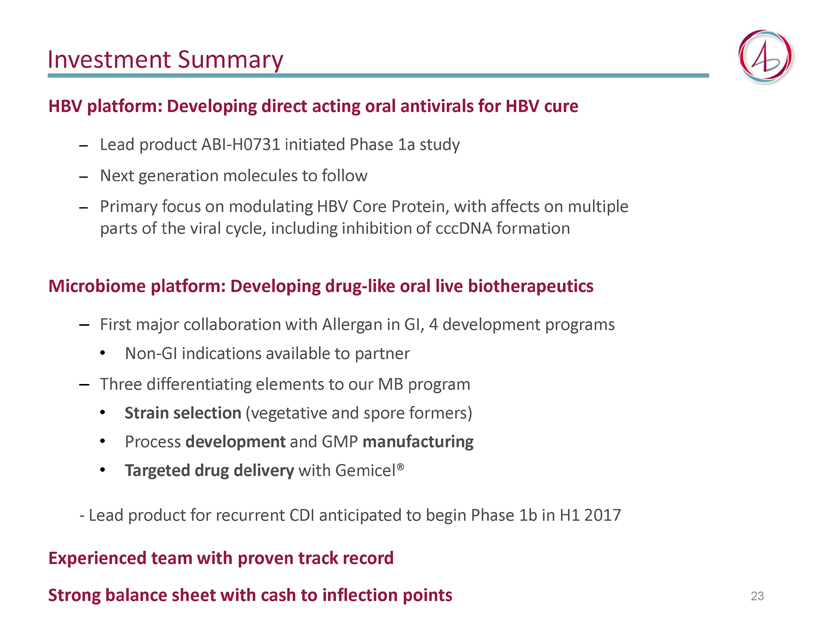
Investment Summary HBV platform: Developing direct acting oral antivirals for HBV cure – Lead product ABI - H0731 initiated Phase 1a study – Next generation molecules to follow – Primary focus on modulating HBV Core Protein, with affects on multiple parts of the viral cycle, including inhibition of cccDNA formation Microbiome platform: Developing drug - like oral live biotherapeutics – First major collaboration with Allergan in GI, 4 development programs • Non - GI indications available to partner – Three differentiating elements to our MB program • Strain selection (vegetative and spore formers) • Process development and GMP manufacturing • Targeted drug delivery with Gemicel® - Lead product for recurrent CDI anticipated to begin Phase 1b in H1 2017 Experienced team with proven track record Strong balance sheet with cash to inflection points 23
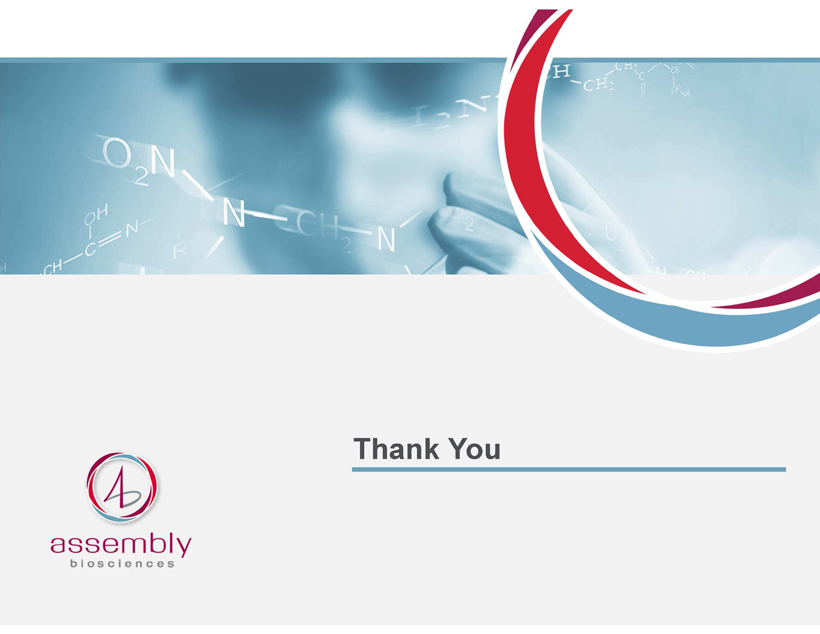
Thank You
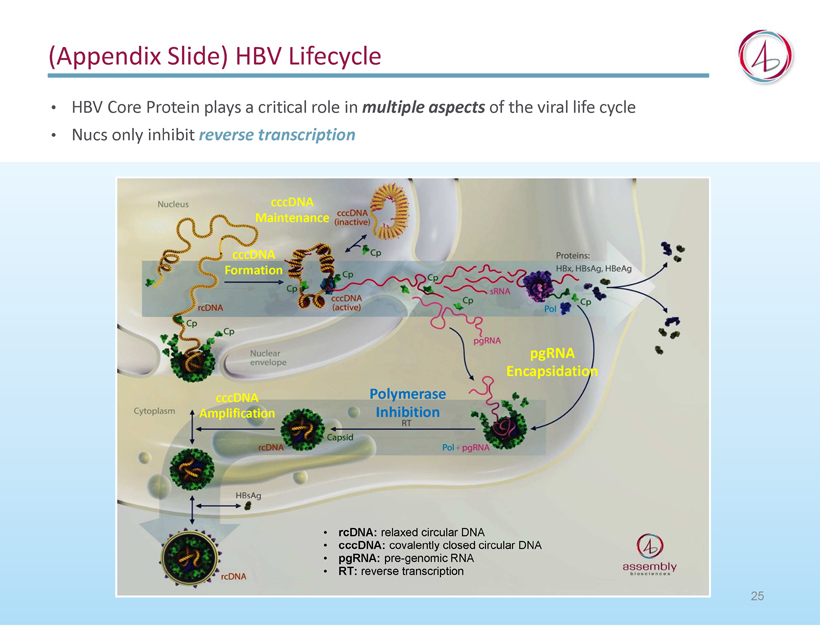
(Appendix Slide) HBV Lifecycle • rcDNA: relaxed circular DNA • cccDNA: covalently closed circular DNA • pgRNA: pre - genomic RNA • RT: reverse transcription cccDNA Formation cccDNA Amplification cccDNA Maintenance pgRNA Encapsidation Polymerase Inhibition 25 • HBV Core Protein plays a critical role in multiple aspects of the viral life cycle • Nucs only inhibit reverse transcription
